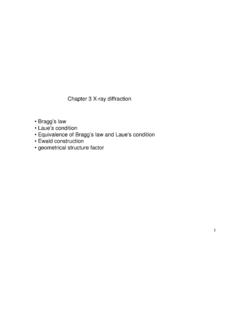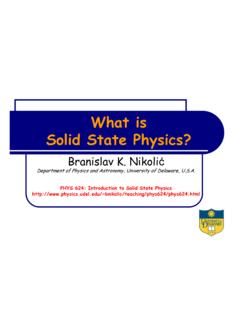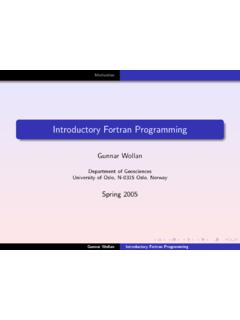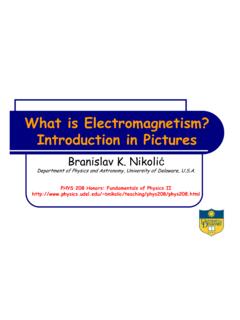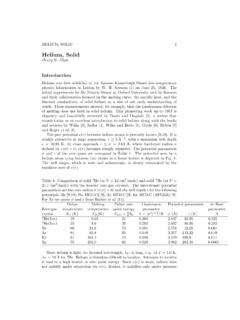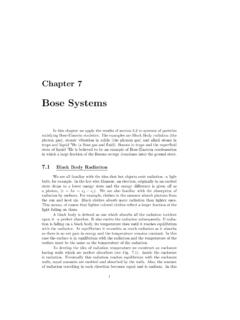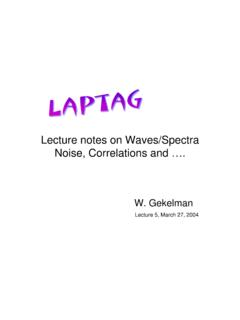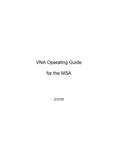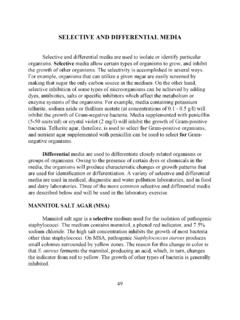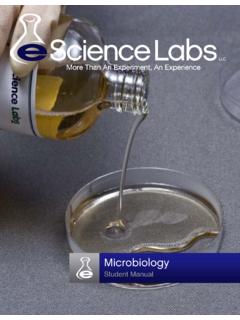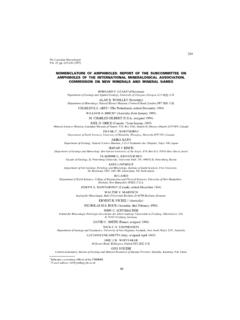Transcription of L5.P1 Lecture 5 Solids Thefreeelectrongas - …
1 Lecture 5 SolidsThefreeelectrongasInasolidstate,af ewlooselybound valence(outermostandnotincompletelyfille d shells) elections become detached from atoms and move around throughout the material being a subjectofthecombinedpotential oftheentirecrystallatticeratherthaniniti alatomic nucleus. We will consider two such models. In the first one,free electron gas, we ignore all forces except confining boundaries and treat our electrons as free particles in the three-dimensional box with infinite assume that our solid is a rectangular box with dimensions ,and thatthe electron inside only experience the potential associated with impenetrable walls, P1 The Schr dinger equationseparates in cartesian coordinates with a wave function written asHere, Lecture 5 Page 1 L5.
2 P2 Making the following substitutions:we getThe solutions of the above equations are cos and sin:Now, we use our boundary conditions. At the infinite walls, our wave function Eq. (1), we get thatFrom Eq. (2), we get the followingNote: has to be positive from its Lecture 5 Page 2 L5. P3 Similarly,The normalized wave functions areand the allowed energies areEach block in this grid, and; therefore, each state occupiesa volume3D k-space with axesImagine a grid with each block in this gridbeing produced with lines drawn atEach intersection point in this blockrepresents a distinct one-particle k-space.
3 Lecture 5 Page 3 L5. P4 Suppose our solid contains N atoms with each atom contributing q free electrons and our solid is in its collective ground state (no thermal excitations).If the electrons were distinguishable particles or bosons they all would have been in the ground state,However, electrons are identical fermions and obey Pauliexclusion principal, so only twoof them can occupy any particular state (two because of thespin, one being "spin up" and another onebeing "spindown"We can say that electrons will fill up one octant ( 1/8 part, see picture) of asphere in radius of that sphere is determinedbythevolume requiredforeachpairof electrons ( ).)
4 We assume that we have N atoms with eachatom contributing q free electrons. Each pairneedsvolume ,we soneedtodivideNq by define the free electron density .The boundary that separates occupied and unoccupied states in k-space is called the Fermi corresponding Fermi energy, the energy of the highest occupied state, is Lecture 5 Page 4 Howdowefindthetotalenergyofa free-electrongas?L5. P5A shell of thickness dk contains a volumeThe number of electron states in this shell isTwo electrons occupy of these states has energyTherefore, the energy of the dk shell in the picture above isTherefore, the total energy is an integral over the k-space up to Fermi surface:This quantum mechanics energy is similar to the internal thermal energy U on the ordinarygas.
5 It exerts a pressure on the walls since if the box expands by dV, the total energy willdecrease:This shows up as work done on the outside by the quantum pressure P. Lecture 5 Page 5 L5. P6 This pressure is sometimes called degeneracy # 1 The density of copper is gm/cm3, and its atomic weight is gm/mole.(a) Calculate the Fermi energy for copper. Assume q=1 and give your answer inelectron volts.(Remember: is number of free electrons per unit volume).Note: Avogadro's number is the number of atoms in exactly 12grams mole is defined as this number of "entities" (usually atoms or molecules) of : to remember Lecture 5 Page 6 (b) What is the corresponding electron velocity?
6 Is it safe to assume that the electrons incopper are non-relativistic?L5. P7(c) At what temperature would the characteristic thermal energy (kBT, where kBis Boltzmanconstant and T is Kelvin temperature) equal the Fermi energy for copper?Comment: This is called Fermi temperature. As long as the actual temperature issubstantially below the Fermi temperature, the materialcan be regarded as the melting point of copper is 1356 K, solid copper is always cold.(d) Calculate degeneracy pressure of copper, in the electron gas : units are supposed to be N/m2. Lecture 5 Page 7
